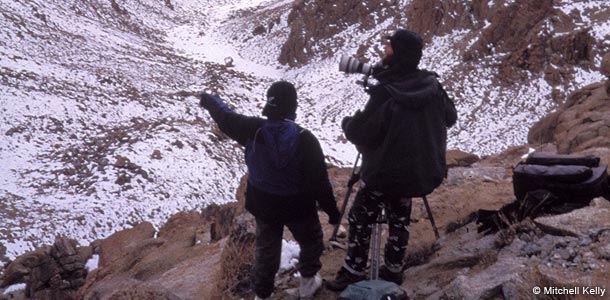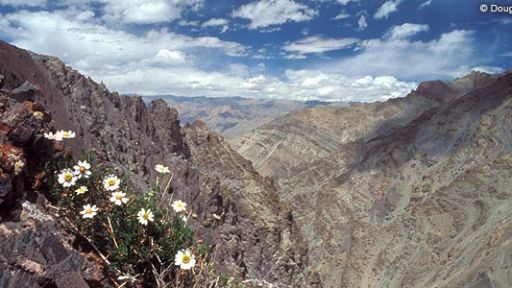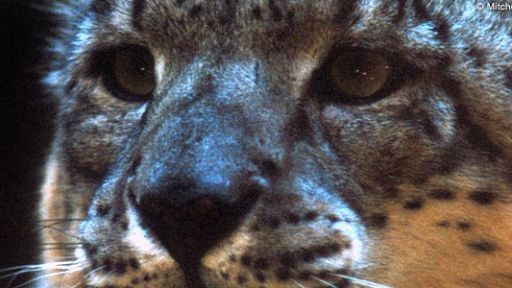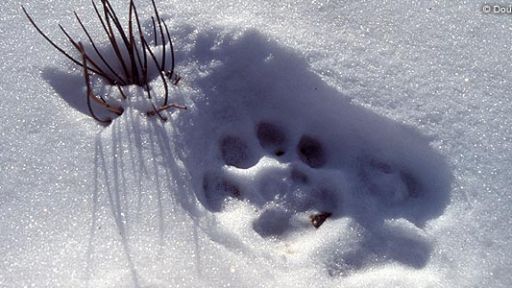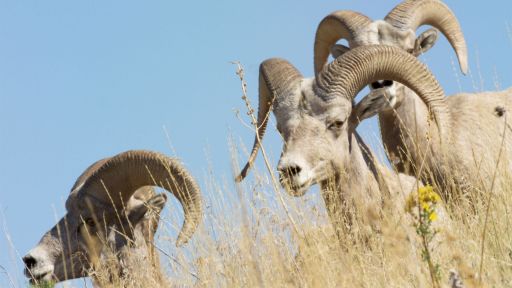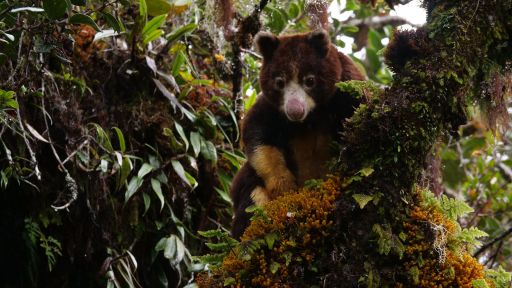One key player in the making of NATURE’s SILENT ROAR was Mitchell Kelly, a wildlife filmmaker. The project, which required months of work at high altitude in isolated areas, was nearly fatal for Kelly. He has since recovered, and recently participated in an interview from his home in the Bahamas.
How did you get involved in the snow leopard project?
In 1998 I was shooting a film on Tasmanian devils in Tasmania. En route to the job I had picked up a copy of Darla Hillard’s book VANISHING TRACKS: FOUR YEARS AMONG THE SNOW LEOPARD OF NEPAL. Darla documents the grueling but seminal snow leopard research her partner Rodney Jackson had conducted in the mid-1980s, aided by her and others. I had always hoped to film snow leopards, but until reading this book I had believed all the hype about how difficult that would be. I put down the book convinced that it would be possible to devise a way to shoot sustained, repeated footage of a wild population of snow leopards.
Then what happened?
Don’t you love the way fate works? Two days after I finished reading the book, I received an invitation to shoot a film in the Himalayas. So from early 1999 to early 2000, I got to test some of the ideas I’d wanted to try after reading Darla’s book. I was also able to incorporate some of the technology that had worked on the Tasmanian devils film, most notably the use of infrared remote video cameras to film nocturnal behavior.
On Christmas Eve, 1999, we got our first footage of a wild snow leopard: a cat walking half into shot, freezing when it hears the faint noise of the camera, and then slowly backing out of shot. We were euphoric. Despite the poor quality of the shot, we had proven that with some slight modifications, the technique would work.
By the time production was over, I had accumulated 28 hours of direct wild snow leopard observation. After that grueling film, I should have been content to do something easier. But I was already planning a bigger snow leopard film, a complete hour just on the cats alone. It now seemed very feasible. Over the following months I received several offers from producers, and eventually chose the WNET/PBS production because of their commitment to support me for the longest amount of time in the field; at that stage, we were planning for three years.
What is your favorite piece of film from the project?
For several reasons, my favorite piece of footage is the courtship and mating sequence. It was my fantasy objective for shoot five. [The film was shot over nine shoots.] I researched all I could about mating strategies of big cats, especially the so-called solitary ones. I needed this comparative approach, since wild snow leopard mating had never been recorded. Many Ladakhi villagers believe that snow leopard females go down to the rivers and mate with male otters, to produce regular snow leopard cubs! So it was a pretty safe bet that even they hadn’t observed mating.
The mating sequence was a genuine team effort. After the isolation of the first four shoots, this shoot was a relatively social one. For the first time I had another film professional in the field with me, camera assistant Stacy Cross. Dr. Rodney Jackson was conducting research and education work in the area for the Snow Leopard Conservancy. Rod and I decided to merge our camps, and together we spent many cold nights discussing the chances of seeing or filming a mating.
Just before dusk one afternoon Rod heard and then saw a female snow leopard yowling from a cliff, a few hours walk from camp. Early the following morning the team went to the site. In the darkness before dawn we could hear the female leopard yowling about halfway up the cliff. But about twenty minutes before it would be light enough to see, she stopped calling. As dawn broke, we got a glimpse of her as she walked into a ravine and out of view. Rod and I immediately moved our tents to a cluster of bare willow trees beneath the cliff.
It took five days at the base of the cliff before it happened. The female yowled for a couple of hours each morning, then stopped about half an hour before first light. On the fifth morning, she didn’t yowl before dawn. It was either a bad sign (she’d left the area) or a good sign (a male had found her and she didn’t need to keep yowling). That morning I was slowly scanning the area as usual when another team member spotted two snow leopards together, very high up on the skyline of the cliff. I rushed to a filming position and threw the camera kit together. I had the cats covered, and already in those first few minutes I could see that they were courting.
The next nine hours were glorious: will they, won’t they? I didn’t take my eye off the viewfinder once. Just before dusk this wonderful team of people made the first-ever recorded observation of a wild snow leopard mating. I’m still deeply moved whenever I watch the footage, both for its content and for its process. After working so hard together over three years and two films, we had just become a part of snow leopard history. Not only that, we’ve cleared up that tale of otters and snow leopards!
What was the hardest part of the project?
By far the hardest part was being away on location so much while my baby son was seriously ill at home. Just before shoot two, my first son, Taiga, was born. His birth was very difficult, and his first two days of life were spent isolated in a humidicrib, with three more under 24-hour care. At the time there was no explanation for his illness. I delayed my return to Ladakh, the film location, as much as possible. But as soon as Taiga had stabilized and was released from the hospital I returned to location. Leaving your six-day-old baby for the next two months tears a piece out of you that never quite grows back, made worse when that baby is ill.
After shoot two was over I spent a beautiful month with Taiga, now two and a half months old, on location in New Zealand for another film I was shooting. All seemed well. But 36 hours before I was due to return to Ladakh for shoot three, Taiga was diagnosed with an incredibly rare congenital disability called septo-optic dysplasia, a midline brain abnormality. Stunned and heartbroken, I delayed my return to Ladakh as long as I could, and then had to leave to film the seasonal events that simply wouldn’t wait.
Shoot three was one of the most difficult I’ve ever done. I had a satellite telephone with me (for safety reasons, and for communication with my co-producer in England, Hugh Miles), so I was able to make brief weekly calls to my then-wife back in Australia. Each call was emotionally battering as I’d learn of yet another devastating aspect of Taiga’s condition. He was pronounced totally blind; his beautiful blue eyes had no optic nerve connecting them to his brain. My passion to film snow leopards suddenly seemed absurd: Here I was filming an animal to show 80 million strangers around the world, and I was powerless to show my own baby son anything. I had to draw on every technique of psychological discipline I knew of to get through it. But I had to make those weekly calls, no matter how heartbreaking. In a way, shoots four, five, and six were even harder as we became more informed about just how fragile Taiga was.
Two months after I completed shoot six, Taiga’s condition overwhelmed him, at the age of 21 months. He had been born, had lived, and died all within the time I had been shooting this film. I had missed more than half of his life by being away on location. That was the hardest part of this project.
Have you been back since your serious bout of mountain sickness?
I wish it had been just mountain sickness! Yes, sadly, I did try to go back. I was first hit at the end of shoot six, a summer shoot, while looking for cubs at about 16,700 feet. In retrospect, I had probably been suffering from mountain sickness for about a day, but I had self-diagnosed it as hepatitis. By the second day it had deteriorated into a high altitude cerebral edema. I couldn’t complete sentences, or walk without stumbling. Inside, my brain was slowly swelling with fluid. Namgial, my horseman and good friend since the first film, began urging me to descend, but since I was the one who always decided what we did, he respected my slurred responses of, “No worries, mate, I’ll just take it easy today.”
Doug Anderson, the camera assistant in this shoot, got out the first-aid book and slowly convinced me that if I stayed up there I would die before morning. In response I threw up. Doug took this as further evidence that he was right and persisted to bore me into submission. By late afternoon I couldn’t even stand so I finally acquiesced, feeling lousy for letting everybody down.
Namgial got his sturdiest dzho (a hybrid of a cow and a yak), and somehow the team managed to slump me across its back. They humored me when I was dopey enough to insist that my camera gear travel with us on a horse — just in case we see a snow leopard on the way down! I’m glad I didn’t insist on the whole camp coming, as several minutes later I began to cough up froth.
This time I had no delusions. I knew from reading countless mountaineering books that this meant my lungs had begun to fill with fluid, and if I didn’t descend very quickly, I would have about 45 minutes left to live. It took about an hour to drop enough altitude for the froth-coughing to stop, and each time I drifted back into awareness it seemed a little more likely that I would make it.
I spent four months at home trying to recover, and just before shoot seven my doctor gave me the all-clear to return to altitude. Thankfully, he equipped me with numerous bottles of rescue drugs should I lapse into problems again. But six days into shoot seven I had to leave. I spent a week in the Apollo Hospital in New Delhi where a very experienced medical team made it emphatically clear that I’d been incredibly lucky to survive both times, and that a return to altitude would be less than prudent. I won’t be trying it again.
What have you been working on since SILENT ROAR?
A few months after my last snow leopard shoot I began filming a carnivorous marsupial called the spotted-tailed quoll. It was one of the most satisfying films I’ve ever been involved in.
I’m currently working on some other projects, including a snow leopard book. For the next film project, I’m reuniting with my first great love, tropical rainforests. For that project I’ll continue using many of the techniques that I applied to the two snow leopard projects, plus some new ones I’m eager to try. And I do have plans for yet another snow leopard film, which is scheduled to start later this year. As it has quite a different focus from the previous two, I should be able to make this one without returning to high altitudes. I want to close the trilogy with a film that gives something back to the snow leopards, after everything they’ve given me over the last six years.

